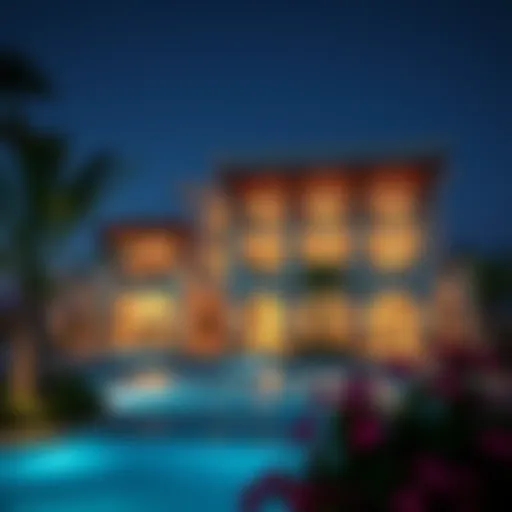Exploring Burj Khalifa: Architectural Marvel and Symbol
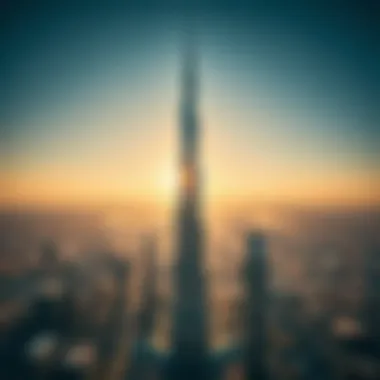
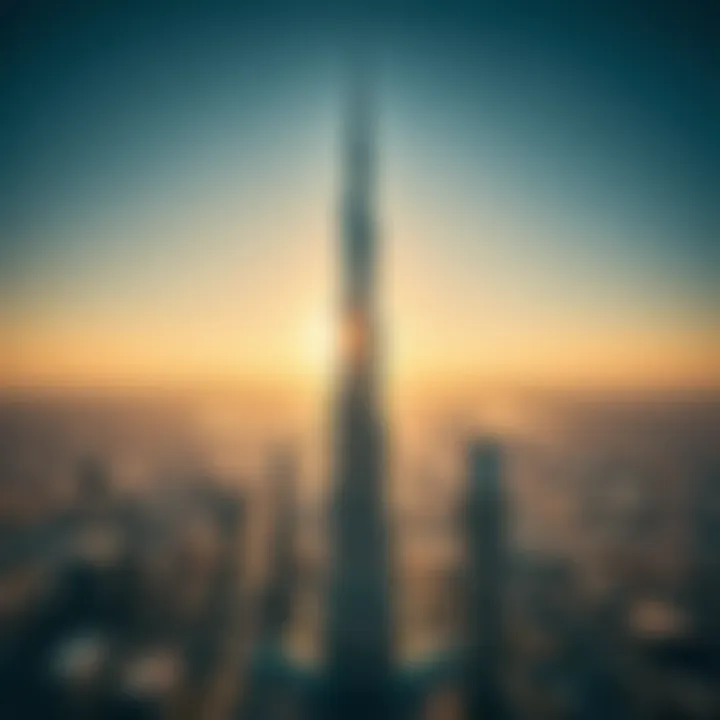
Intro
Burj Khalifa is not just a skyscraper; it's a testament to human ingenuity and ambition. Towering at a dizzying height, it serves as a landmark for Dubai and an emblem of modern architectural prowess. Standing tall, it demands attention and respect, catching the eye of tourists and locals alike. This article aims to peel back the layers of this magnificent structure, exploring its architectural complexity, the engineering hurdles its builders faced, and its significance in the broader context of not only Dubai but the world.
As we traverse through the narrative, we will unpack what makes this building a beacon of innovation. From its striking design blueprint to the challenges faced during its ascent into the sky, every detail paints a picture of a monumental effort. Here, we also look at the building's economic implications – particularly its role within Dubai's real estate market and tourism sector. Whether you are an investor eyeing opportunities, a homebuyer considering a future in Dubai, or a real estate agent looking for insights, this exploration offers valuable perspectives.
Through a detailed discussion, we will dive into the relevance of Burj Khalifa within the intricate weave of Dubai's identity, showcasing how this giant shapes not only the skyline but also the aspirations of a city that has become synonymous with luxury and futuristic living. As we embark on this journey, let’s set the foundation by examining market trends in Dubai’s real estate - as they weave in and out of Burj Khalifa’s extraordinary legacy.
Preface to Burj Khalifa
The Burj Khalifa is not simply a skyscraper; it’s a statement of ambition and engineering prowess that dominates the Dubai skyline. Standing at a staggering 828 meters, it serves as both an architectural marvel and a symbol of the rapid modernization that characterizes this vibrant city. Understanding the Burj Khalifa is vital—not just for its aesthetic appeal but also for its role in reshaping the urban environment and fostering economic growth.
Historical Context
The story of Burj Khalifa begins in the early 2000s, during a time when Dubai was evolving rapidly. Once known primarily for its trade and pearling industry, it was looking to diversify its economy and establish itself as a global city. Construction of the Burj Khalifa commenced in 2004 and took six years to complete, culminating in its official opening in January 2010. What is particularly striking about its history is how it mirrored Dubai's own growth; just as the city was seeking to redefine itself, so was this building—a colossal endeavor that sought nothing less than to be the tallest structure on earth.
"The Burj Khalifa exemplifies Dubai's aim to be recognized on the world stage, showcasing not just architectural skill, but a visionary ambition."
The architectural design, led by the firm Skidmore, Owings & Merrill, was influenced heavily by Islamic architecture. The Y-shaped floor plan is a nod to the desert flower, the Hymenocallis, which beautifully ties the building to its geographical roots. This significant historical context provides a backdrop that enriches any discussion regarding Burj Khalifa, as it’s not just a building but a piece of history that symbolizes hope and progress in the heart of the Middle East.
Purpose and Vision
From its inception, the Burj Khalifa was designed not only to reach for the skies but to serve multiple purposes that enhance both individual and communal living. It is a mixed-use development, incorporating residential, commercial, and hospitality spaces into its towering structure. The vision was clear: create a destination that invites people from around the world, offering them luxurious living spaces, fine dining, and breathtaking views.
The Burj Khalifa was envisioned to attract tourists, investors, and business professionals. By housing a luxurious hotel operated by Armani, alongside high-end residences and corporate offices, it set out to elevate the standard of living and business sophistication in Dubai. Moreover, the surrounding developments—the vast Dubai Mall and the expansive Downtown Dubai area—serve to create an entire ecosystem, boosting the attractiveness of the city as a global hub.
This multi-faceted purpose, coupled with a clear vision for integration within its urban environment, distinguishes the Burj Khalifa not just as a feat of engineering, but as a keystone in Dubai's continuing narrative of commercial and residential expansion.
Architectural Details
When it comes to understanding Burj Khalifa's place as an architectural icon, the details are crucial. We often think about how tall it is or how grand it looks from a distance, but the intricate architectural elements contribute significantly to its status as the tallest building in the world. The design and materials not only enhance its aesthetic appeal but also serve important functional roles that accommodate both the residents and visitors.
Design Inspiration
The design of Burj Khalifa draws heavily from the cultural influences of the region. Its shape is reminiscent of the hymenocallis flower, particularly evident in the way the building spirals upwards, mimicking the petals as they open towards the sky. The architectural firm Skidmore, Owings & Merrill took elements from Islamic architecture, incorporating multi-faceted surfaces which reflect light differently, giving the building an ever-changing appearance throughout the day. This design choice is not just about looks; it’s about creating a structure that feels connected to its environment.
Additionally, the structure incorporates local traditions and artistry by utilizing patterns commonly found in Islamic art. These detailed motifs are a nod to Dubai's rich historical background and reflect a blend of contemporary and cultural artistry. The tower’s setback design, tapering as it ascends, is also a deliberate choice aimed at reducing wind loads, making the building stable and safe, while also giving it a commanding silhouette against the skyline.
"The Burj Khalifa does not merely stand as a building; it is a living reflection of the spirit of innovation and cultural pride in Dubai."
Materials Used
The Burj Khalifa is as much about its materials as it is about its pioneering design. A plethora of advanced materials were utilized in its construction to ensure its durability and performance. The primary material, reinforced concrete, was chosen for its strength and ability to withstand the high pressures at the tower's upper levels. A remarkable 103,000 square meters of glass encapsulates the structure, offering breathtaking views while contributing to energy efficiency.
In addition, the lower levels feature cladding made primarily from stainless steel, giving it a striking polished finish that reflects the sun and shimmers during different times of the day. The exterior's reflective quality not only enhances its striking appearance but also helps regulate temperature inside the building, thereby lowering energy costs.
The overall construction method made extensive use of local materials, aiming to minimize the carbon footprint. Furthermore, elaborate ceramic and steel lattice frameworks can be seen on the surfaces, providing strength while also maintaining an aesthetically pleasing facade. This intricate combination of design and material underscores a broader commitment to redefine what modern architecture can achieve, both functionally and visually.
In essence, the architectural details of Burj Khalifa are not mere frills; they embody the spirit of innovation and sustainability, serving both the demands of a modern city and honoring its rich heritage.
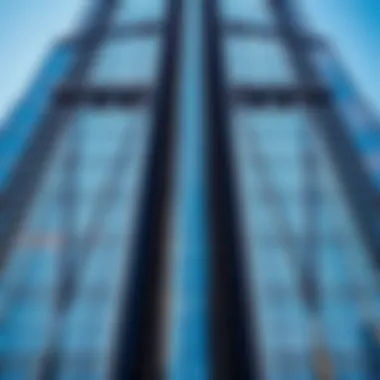
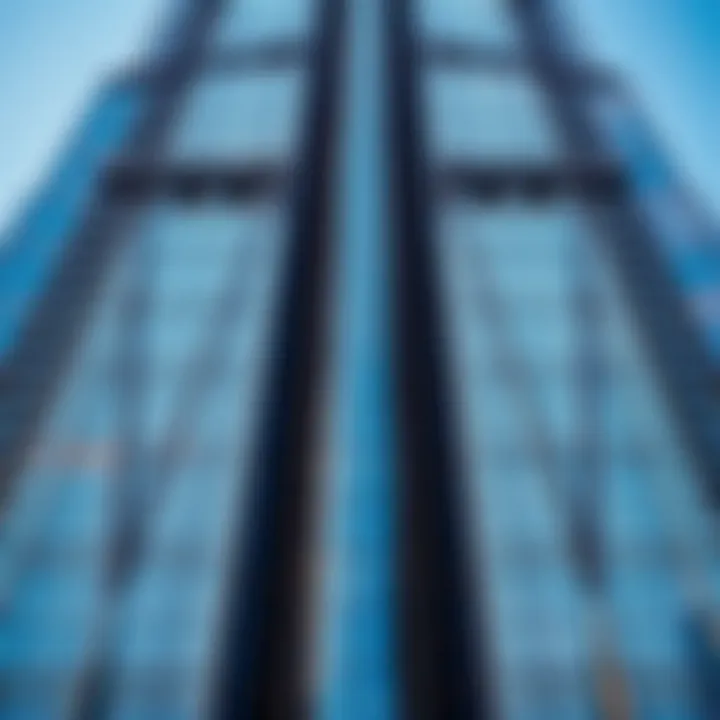
Construction Insights
The construction of Burj Khalifa is a testament to human ingenuity and resilience. This section aims to delve into the significant elements that contributed to the building's unparalleled height and architectural marvel. Understanding these insights is crucial for anyone interested in high-rise development, as they reveal the intricacies involved in transforming ambitious visions into reality.
Timeline of Development
The journey of Burj Khalifa from blueprint to towering reality is filled with milestones that highlight meticulous planning and execution. Construction began in 2004, and after years of relentless effort, the skyscraper was completed in 2010. Here’s a brief timeline of its major phases:
- 2004: Groundbreaking initiated with the site preparation.
- 2005: The foundational work began, featuring a large concrete mat laid to support the tower.
- 2006: The structure began to rise, with the first few levels established.
- 2007: Reaching halfway, the construction crew faced both triumphs and setbacks, but the vision remained undeterred.
- 2010: Officially opened on January 4, this marvel created a new icon for Dubai, redefining its skyline.
Engineering Challenges
Constructing the tallest building in the world brought along a variety of engineering challenges that tested the limits of modern construction technology. Key hurdles included:
- Wind Resistance: Given the tower's extreme height, special attention was given to wind loads. Engineers conducted extensive simulations to ensure stability in harsh conditions.
- High Temperatures: The summer heat in Dubai posed risks for workers and materials. Strategies were implemented, including nighttime pours of concrete to manage temperature.
- Foundation Engineering: The design required a massive foundation capable of supporting a structure weighing over 500,000 tons.
"The most remarkable characteristic of Burj Khalifa’s foundation is its sheer volume and complexity, akin to building a ship in the ocean."
Innovative Techniques
The construction of Burj Khalifa incorporated innovative techniques that are now benchmarks for future high-rise projects. Among these advancements are:
- Jump Form System: This technology allowed builders to erect the concrete floors rapidly, effectively reducing the overall construction timeline.
- Ducted Air Conditioning: Instead of traditional air conditioning, advanced ducting techniques improved energy efficiency while ensuring comfort for occupants.
- Concrete Mix Formulation: A specialized concrete mix was created that could withstand high pressure, thus enabling the tower to achieve its record height.
In summary, the construction insights of Burj Khalifa offer a deep dive into the rich tapestry of engineering, planning, and innovation behind this architectural landmark. Each process, from the initial timeline of development to overcoming engineering challenges and employing groundbreaking techniques, showcases a dedication to excellence that is vital for anyone interested in the future of skyscraper construction.
Height Specifications
Understanding the height specifications of the Burj Khalifa is crucial not just for enthusiasts of architecture and engineering, but also for potential investors, homebuyers, and real estate agents. The towering structure serves as a beacon of progress, marking a significant achievement in modern architecture. Its height plays a pivotal role in defining its identity, from the striking silhouette it casts against the Dubai skyline to the technological innovations that sustain it. Height specifications are not just numbers; they tell stories of aspiration, capability, and a vision turned into reality.
Total Height
The total height of the Burj Khalifa stands at an impressive 828 meters (2,717 feet). When it was completed in 2010, it not only claimed the title of the tallest building in the world but also set a benchmark for skyscraper design globally. This height is essential, as it conveys Dubai's ambition and its desire to be at the forefront of modernity.
To enhance the understanding of this enormous height:
- It’s about more than just size. The height is an engineering marvel achieved through advanced materials that ensure stability and durability in extreme weather conditions.
- The view from the top, accessed by the highest observation deck in the world, is not only breathtaking but also a significant draw for tourists, strengthening the city’s economy.
Number of Floors
The Burj Khalifa boasts 163 floors above ground, accommodating both residential and commercial spaces. This was not just an architectural decision; it reflects the intended functionality of the building. The diverse use of these floors accommodates residents, hotel guests, and office workers under one roof. Future homebuyers and investors will be keen to note:
- The variety of spaces allows for a mixed-use environment, encouraging a vibrant community.
- The integration of assorted facilities helps in increasing property value. High floors, with spectacular views, tend to be more sought after.
Observatory Levels
The Burj Khalifa features two main observation decks located on the 124th and 148th floors. These spaces offer unparalleled views of the city and beyond, attracting thousands of visitors each day.
The significance of the observatory levels is profound:
- They are not just tourist destinations; they generate substantial revenue for the city and foster a sense of pride among locals.
- Having such observation points promotes Dubai as a global city, giving those visiting an immersive experience of its culture and architectural prowess.
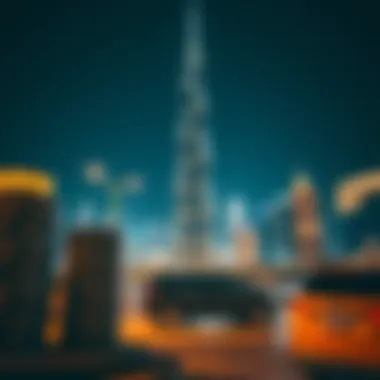

"All around, the sheer scale of Burj Khalifa offers not just views—but a lens through which the world can gaze at Dubai’s innovation and ambition."
In summary, the height specifications of the Burj Khalifa present more than just remarkable numbers—they encapsulate a contemporary vision of a city ready to embrace the future. Investors and homebuyers can particularly appreciate how these specifications translate into opportunities within the real estate market, as the allure of living and working in such a monumental structure continues to inspire dreams.
Functionality of the Building
Burj Khalifa is not only an architectural wonder but also serves diverse purposes that enhance its significance within the urban landscape of Dubai. The functionality of this building is paramount to understanding how it operates as a social and economic hub. From residential areas to commercial spaces and hospitality services, Burj Khalifa integrates multiple functions that reflect a blend of modernity and tradition. The interplay of these elements ensures that the building is not just a tall structure but a vital component of Dubai's identity.
Residential Areas
The residential spaces of Burj Khalifa are designed for luxury living that offers residents breathtaking views of the city and beyond. Occupying floors 19 to 108, these residences include 900 private homes, which range from one to four-bedroom apartments. Each unit is equipped with state-of-the-art amenities, providing a blend of comfort and sophistication.
Living in a space that sits a half-kilometer above ground offers a unique lifestyle experience. The height not only gives residents some of the most stunning vistas available but also provides a level of privacy that is hard to find elsewhere. Moreover, the building incorporates world-class security measures, making it an attractive option for wealthy individuals. Also, the community feels fostered in this towering edifice allows for both privacy and social interactions among residents, creating a unique urban lifestyle.
Commercial Spaces
Burj Khalifa houses some of the most prominent commercial spaces in Dubai, encompassing floors 1 to 15 as well as certain areas on floors 148 and 153. These spaces, tailored for major corporations, startups, and international businesses, are highly sought-after due to their prestigious address and modern infrastructure. The commercial sectors boast various facilities, including conference rooms, office spaces with panoramic views, and cutting-edge technology designed to facilitate business operations.
The building's location plays a crucial role in its commercial appeal. Situated near the Dubai Mall and other central business districts, it attracts both foot traffic and potential investors. This location is not just about business; it is about creating a network of professionals that thrive on innovation and collaboration. Many enterprises operating in Burj Khalifa benefit from the exposure that comes with such an iconic setting, thus boosting their visibility and marketability.
Hospitality Services
Burj Khalifa is home to the luxurious Armani Hotel, which occupies the first 39 floors. Established by renowned fashion designer Giorgio Armani, this hotel combines luxury with personalized service, making it a prime choice for both tourists and business travelers. With its elegant design and exclusive services, the hotel doesn’t just capture the essence of high-end living; it sets new benchmarks in the hospitality industry.
In addition to the hotel, there are various dining options and leisure facilities that attract visitors, further embedding Burj Khalifa into the tourism fabric of Dubai. For instance, the observation decks on floors 124 and 148 not only serve as tourist magnets but also as platforms for social gatherings, events, and business meetings, thereby enriching the overall experience.
Overall, the functionality of Burj Khalifa is a testament to modern design and urban planning. The balance between residential, commercial, and hospitality services exemplifies how multi-faceted the structure truly is, providing a concrete paradigm on the benefits of integrated development in urban settings.
Cultural Significance
The Burj Khalifa stands not merely as a structure of steel and glass; it embodies the aspirations and identity of a young city like Dubai. Its towering presence has become a beacon not only for the UAE but for the world. When discussing the cultural significance of this marvel, we find layers that go beyond architectural prowess.
Symbol of Modernity
The Burj Khalifa is often referred to as a symbol of modernity, drawing eyes from around the globe. Rising 828 meters, the skyscraper exemplifies cutting-edge engineering and design philosophy. It’s a striking reminder of what is achievable when ambition aligns with innovation. Built during a period of rapid globalization, the tower resonates with Dubai's relentless push to be a forefront player in the global economy.
In many ways, the Burj Khalifa stands as an emblem of progress; it captures the essence of a future where architectural boundaries are meant to be challenged. Its design is inspired by traditional Islamic architecture, yet it boldly incorporates modern aesthetics, showcasing the city’s culture in its height and footprint. This interplay of the old and the new illustrates a society that cherishes its heritage while eagerly embracing the evolution of technology and design.
"This structure is not just a skyscraper; it’s a statement that dreams can reach great heights."
Tourism Impact
Tourism is another realm where the Burj Khalifa exerts undeniable influence. The building draws millions of visitors each year, becoming an integral part of the tourism economy in Dubai. Here's how:
- Attraction Magnet: The Burj Khalifa is often the first stop for tourists and contributes significantly to Dubai's profile as a top tourist destination worldwide.
- Economic Boost: Increased foot traffic boosts local businesses, hotels, and restaurants as visitors flock to the area, showcasing how a single structure can ripple through the economy.
- Cultural Hub: Events held in and around the Burj Khalifa—such as light shows, fireworks, and festivals—transform the tower into a cultural hub, attracting diverse crowds and fostering community spirit.
The fusion of a modern icon within a traditionally rich backdrop gives Burj Khalifa its unique charm. The structure not only symbolizes Dubai's ambition, but also acts as a bridge connecting cultures and inviting global dialogue.
Tourism related to the Burj Khalifa is an intricate tapestry woven from its significance over time. The building proves that architecture transcends its physicality; it tells a story of hope, aspirations, and shared experiences, making it not only a landmark but a cultural phenomenon.
Sustainability Practices
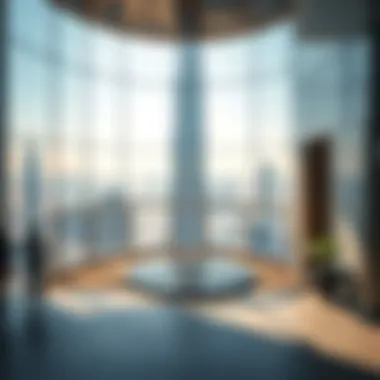
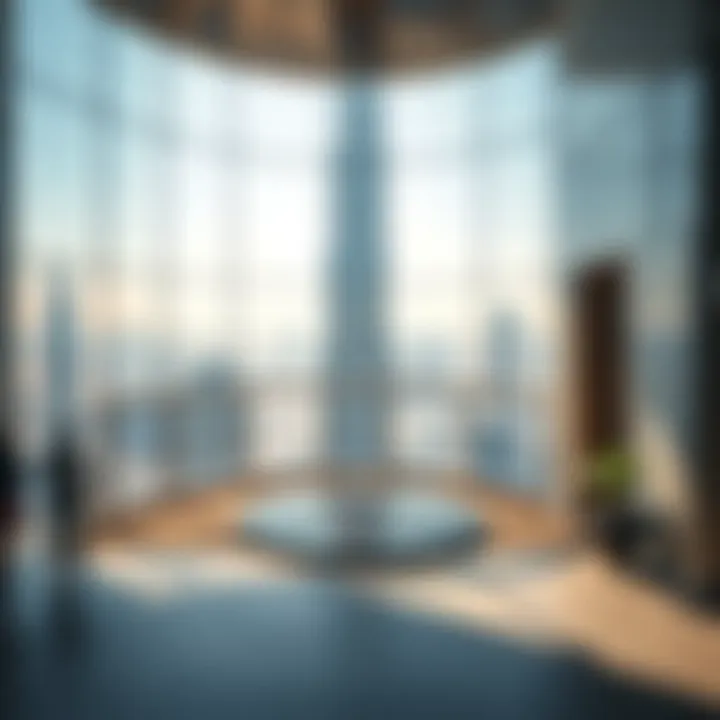
The Burj Khalifa is not merely a pinnacle of architectural achievement, but also a beacon of sustainability in one of the world’s most arid regions. The importance of sustainability practices in the context of this skyscraper extends beyond mere aesthetic or novel aspects; they reflect a commitment to responsible development, preserving resources while creating a landmark that embodies modernity. As global awareness regarding climate change and environmental degradation intensifies, Burj Khalifa serves as a model of how skyscrapers can harmonize with ecological principles.
Energy Efficiency
At the heart of Burj Khalifa's sustainability efforts lies a commitment to energy efficiency. With its sleek design and state-of-the-art technologies, the building minimizes energy usage remarkably. The innovative double-glazed glass façade not only provides aesthetic appeal but also plays a vital role in regulating the building’s temperature, ensuring that heat is kept out while allowing natural light to permeate the interiors. The building employs a high-efficiency cooling system that reduces power consumption by utilizing a chilled water system rather than traditional air conditioning.
Moreover, the implementation of automated lighting controls further enhances energy-saving measures. Sensors detect natural light levels and adjust artificial lighting accordingly, ensuring that electricity is used efficiently without compromising occupant comfort. Burj Khalifa’s smart building management system also allows for real-time monitoring and optimization of energy consumption. This level of integration illustrates how technology can be leveraged to drive energy efficiency.
Water Conservation Strategies
Water scarcity in desert climates makes efficient water usage a fundamental consideration in construction and architecture. Burj Khalifa incorporates numerous water conservation strategies that reflect a deep understanding of this challenge. The building features a rainwater harvesting system, capturing and repurposing rainwater that falls on its surface, which is then used for irrigation and cooling. This not only reduces dependency on municipal water supplies but also helps replenish local groundwater.
In addition to harvesting rainwater, the irrigation system utilizes reclaimed water, treating wastewater for non-potable uses within the building. Landscaping is designed with native plants that require minimal irrigation, further promoting conservation. Together, these strategies not only conserve water but also contribute to a sustainable environment.
"Sustainability isn’t just a buzzword for Burj Khalifa; it’s part of its very fabric. Every decision made reflects a drive towards creating a better balance with nature."
With initiatives such as these, Burj Khalifa exemplifies a new standard for high-rise buildings, where luxury seamlessly meets environmental responsibility. Investors and stakeholders can look to this iconic structure as a pivotal example of how modern buildings can be designed with the future in mind, blending urban living with sustainability.
Future Prospects
The Burj Khalifa stands as a towering feat of human ingenuity and architectural prowess. However, the journey doesn’t end with its completion. The future prospects of this iconic structure are pivotal in not only shaping Dubai’s skyline further but also enhancing its role in global tourism and real estate development. Understanding these future prospects is essential for potential investors, homebuyers, and real estate agents looking to capitalize on the unique opportunities that arise from this landmark.
Ongoing Developments Around Burj Khalifa
In the shadows of the Burj Khalifa, a myriad of ongoing developments paints a picture of a vibrant urban landscape. Projects surrounding the tower include mixed-use developments, luxury hotels, and spacious parks that cater to both tourists and locals alike. Among the notable initiatives:
- Dubai Creek Tower: A competitor in height aspirations, this tower aims to reach new heights, adding prestige to the area. Its construction is closely tied to the success of Burj Khalifa.
- Dubai Mall Expansion: Enhancements to the existing Dubai Mall promise to introduce more retail and entertainment options, further attracting foot traffic to the vicinity.
- Cultural Projects: Plans for museums and art galleries aim to enrich the cultural fabric of the area, promoting creativity and tourism.
These developments not only foster economic growth but also create networks that enhance Burj Khalifa's attractiveness as a central hub for activities. Such additions could potentially raise property values and spark interest from businesses looking to be part of a thriving area.
Investment Opportunities
Investing near the Burj Khalifa is akin to purchasing prime gold. The high demand for residential and commercial spaces in this prestigious location continues to drive interest from multiple sectors. Some key areas for investment consideration include:
- Luxury Condominiums: With developments like the Residences at Burj Khalifa, there’s a steady demand for opulent living spaces. These offer not just homes but a lifestyle intertwined with luxury.
- Retail Ventures: With the expanding mall, opportunities abound for businesses looking to tap into affluent clientele. Retailers can thrive by establishing their presence here.
- Corporate Offices: The allure of having an office with a view of the iconic tower is undeniable. Many companies wish to associate their brand with such landmarks, which can result in higher rental yields.
Investors should be mindful that as new projects unfold, market conditions may shift. Staying attuned to supply and demand dynamics is crucial. One must weigh the risks and rewards diligently, as the landscape can change quickly.
"The development around the Burj Khalifa signifies not just growth but transformation in urban living, where opportunities are limitless."
As these prospects unfold, the Burj Khalifa will continue to serve not just as a landmark but as a beacon of opportunity in a rapidly evolving city.
Finale
In drawing the curtains on our exploration of Burj Khalifa, it's essential to indulge in the significance and impact of this architectural wonder. Beyond being the tallest building in the world, Burj Khalifa serves as a beacon of progress, innovation, and ambition. Its incredible height not only reshapes the Dubai skyline but also symbolizes the potential of human ingenuity in overcoming monumental challenges.
The benefits that stem from such a structure are multifaceted. Economically, the Burj Khalifa attracts millions of tourists annually, fostering growth in the hospitality and service industries. Additionally, its presence has encouraged real estate development, transforming the surrounding area into a bustling hub for investment opportunities.
From an engineering standpoint, the Burj Khalifa stands as a testament to advanced construction techniques and materials. The lessons learned from its development have influenced high-rise projects globally, making it a reference point in architectural education and practice.
Consideration of the Burj Khalifa’s environmental initiatives also adds another layer of importance to this narrative. The building isn’t just about aesthetics; it incorporates sustainability measures that push the boundaries of traditional construction ethics. This aspect resonates with investors and stakeholders, who are increasingly looking to back projects that prioritize eco-friendliness and resilience against climate change.
"Burj Khalifa is not just an iconic structure; it is a narrative of ambition, culture, and innovation, redefining what is possible in architecture.”
Thus, the essence of our concluding thoughts highlights the Burj Khalifa's role not just as a physical edifice, but as a cultural and economic symbol that embodies the spirit of Dubai's transformation and the limitless possibilities within the realm of architecture. For investors, homebuyers, and real estate professionals, understanding the depth of this iconic building can open doors to myriad opportunities, advancing both personal and professional prospects.
In summary, Burj Khalifa is a pivotal part of the city's canvas, encompassing dreams, aspirations, and a glimpse into the future of architectural excellence.



